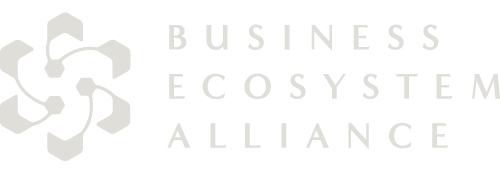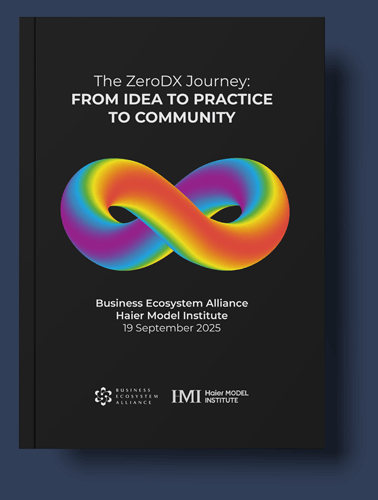Leadership in an Ecosystem Age
By Futurist John Hagel, Dr. Marshall Meyer, and Dr. Annika Steiber
While everyone today is talking about ecosystems, there are still significant opportunities that have not yet been addressed.
Companies are under increasing pressure from investors to deliver greater growth, but most companies still view growth as a choice between growing internally or growing through acquisition. They miss the third option — leveraged growth through ecosystems. Leveraged growth involves connecting with and mobilizing a growing number of third parties to deliver increasing value to customers. The company can capture some of that value for itself and generate growth in revenue with far fewer resources and far more quickly than either of the traditional growth options. This growth opportunity can be generated by downstream ecosystems, covering a larger share of users’ needs.
On the upstream side, ecosystems can create significant additional value as well. Most businesses today rely on supply chains. As the name implies, supply chains tend to be very rigid. In a rapidly changing world with greater uncertainty, we need to focus on creating larger and more diverse supply networks that can provide much greater flexibility and specialization. Also, on the upstream side, there is an untapped opportunity to create a broader network of third parties to help develop new products as product life cycles continue to shrink.
When discussing ecosystems, most could be viewed as static. These static ecosystems focus on connecting with existing resources through short-term transactions. There is an untapped opportunity to shift from static ecosystems to dynamic ecosystems. Dynamic ecosystems are driven by a very different goal: creating an opportunity for all participants in the ecosystem to accelerate their performance improvement by learning faster together. The most valuable learning in a rapidly changing world is learning in the form of creating new knowledge, not just sharing existing knowledge. New knowledge can be created most rapidly through action together with others. This requires building deep and enduring trust-based relationships with others. Few companies have yet embarked on the effort to design and deploy dynamic ecosystems even though they have the potential to unleash exponentially expanding opportunities.
Companies that lead in an ecosystem age
One high-growth ecosystem company that’s not quite a household name is Sonos.
Sonos connects users with thousands of digital music sources globally via its proprietary platform that is integrated with other platforms like alarm.com. Sonos can then direct different streams of music to each Sonos-capable device in the home or the business facility. Multiple inputs, multiple platforms, and multiple partnerships embedding Sonos technology in ceiling panels and furniture and multiplex distribution, define their ecosystem.
However, Sonos began as a tech company with the explicit goal of leading growth by using an ecosystem of music. Haier is a great example of a traditional company that has strategically moved in the direction of ecosystems for growth. For example, Haier’s vision of the ‘Internet of Clothing’ aims to do for clothing what Sonos does for music—to digitally tag clothing, to track clothing digitally, from its design to manufacturing, distribution, utilization, care, and ultimately disposal, with benefits for almost all players, consumers, and society especially. The company’s ecosystem strategy has been under development for years. “Mr. Cleare” opened in December 2019 and is an integral part of Haier’s IoC ecosystem strategy. Clothes brought to “Mr. Cleare” get digital tags to insure they are laundered properly. The next generation of Haier home washing machines will also be able to read these tags to insure proper laundering of garments. Smart closets will also read these tags and organize clothing digitally.
Another example of a traditional company moving to an ecosystem strategy is GE Appliances.
In 2016, GE Appliances (GEA) became part of Haier. As a result, GEA started to practice the new management principle- zero distance to users, a vision of 0 distance between company employees and the users. To make this a reality, the company first had to break down the large organization, managed for scaled efficiency, into smaller, user focused units. The power was taken from the CEO and put it into the smaller businesses, called microenterprises. The microenterprises were then encouraged to be highly entrepreneurial and find opportunities for growth and aim for zero distance to the users. GEA labels this first phase, the ‘microenterprise phase’. In 2021, GEA entered a new phase, the ‘ecosystem phase’. The company was now to become the leading ecosystem player in their industry!
For the CEO, Kevin Nolan, this new phase meant that the company now needed to understand not only in what arenas they play and what the users expect from the company and its offerings, but also what ecosystems the company already is involved in and should tap value from. If the company would understand this, partnerships could then be made with key partners, and together with GEA deliver a higher value to the users than ever before in a true win-win fashion. GEA already sees positive results from its transformation and as a result, GEA has been growing more during the last five years than during the previous 25 years. Kevin Nolan now seeks to lead the company in an ecosystem age.
To wrap up, companies are already competing in an ecosystem age, but few traditional firms have truly transformed their business models in ways fit for the new age. New players such as Sonos, but also more traditional companies like Haier and GEA are taking market share based on their competitive age- leadership for the ecosystem age!


